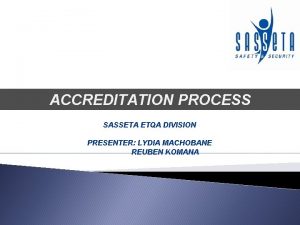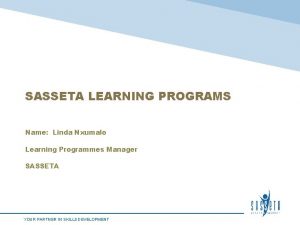National Skills Development Plan NSDP SASSETA Research Department








- Slides: 8

National Skills Development Plan (NSDP) SASSETA Research Department Leaving a legacy. Making the future count.

NSDP Mission, Vision and Purpose VISION MISSION ‘An Educated, Skilled and Capable Workforce for South Africa’ To improve access to occupations in high demand priority skills aligned to supporting economic growth, employment creation and social development whilst also seeking to address systemic considerations. PURPOSE NSDP is reorienting and investing in higher education to meet the skills (future) demand to to bring about qualitative changes in the field of education

Drivers for NSDP National Development Plan (NDP) 1. Raising employment through faster economic growth; 2. Improving the quality of education, skills development and innovation; and 3. Building the capability of the state to play a developmental, transformative role. 4. Expand the college system with a focus on improving quality. Better quality will build confidence in the college sector and attract more learners. White Paper on PSET 1. The design of training systems and curricula require close cooperation between education providers and employers. 2. SETAs and NSF have a crucial role to play in facilitating such workplace learning partnerships between employers and educational institutions. 3. SETAs role will be narrowed engage workplace stakeholders in terms of needs and capacity 4. SETAs and NSF through DGs will fund skills development capacity in public education institutions Skills Development Act (SDA) (a) to develop the skills of the South African workforce (b) to increase the levels of investment in education and training in the labour market (c) to encourage employers to provide opportunity to new entrants to gain work experience (d) to encourage workers to participate in learnership and other training programmes; (e) to improve the employment prospects of persons previously disadvantaged 3

NSDP Outcomes 8. Support career development services 1. Increase production of high demand occupations 2. Linking education and workplace Institutional Arrangements of the SETAs 1. SETAs will have no limited lifespan but a mechanism to address non-performance will be established; 2. Where required, the Minister will introduce institutional reviews, as the socio-economic policy environment is not static; 3. SETAs demarcation, amongst others, will be based on industrial classification, value chain and financial viability; and 4. Establishment of Shared Services, where practically possible. Critical improvement of NSDP 7. Support worker initiated training 6. Entrepreneurial and cooperatives NSDP goals 3. Improve the level of workforce skills 4. Increase access to occupationally directed programmes 5. Support growth of public colleges Increased standardisation of processes related to the key functions of the SETAs which will allow effective and efficient monitoring. Service Level Agreements will be guided by the NSDP priorities, where required will be multiyear agreements. Budgets, expenditure and systems will be managed through: 1. Administering the skills grants against the agreed upon priorities and timelines, 2. Working with the shared services, where applicable, to ensure a consistent application process for workplaces and potential learners. 4

Principles for the NSDP 1. Integration within the PSET system, focusing on the coordination of planning, funding, monitoring, evaluation and reporting more importantly by skills levy institutions 2. Emphasis on inclusive growth and employment generation as set out in the NDP, the NGP, the Industrial Policy Action Plan (IPAP) and other key policy documents of government. 3. The transformational and redress imperatives focusing on addressing equity in relation, amongst others, to class, gender, race, youth, geography and disability 4. Collaboration through partnerships within the public sector as well as between the public and private sectors to support effective skills development – workplace integrated learning 5. Improve efficiency and effectiveness of decision making, planning, allocation of funds, implementation, and quality assurance also harnessing the use of technology to standardise processes across all skills levy institutions where possible. 5

Principles for the NSDP 6. Strong emphasis on accountability in terms of improving the governance oversight, monitoring and evaluation mechanisms and to ensure that actions are taken based on findings from these monitoring and evaluation systems 7. Partnerships and collaboration with the higher education and research institutions, amongst others, will be central for evidence based understanding of skills demand supply. SETAs will continue to gather credible information from the workplaces to understand the demand for skills and occupations, both nationally and within sectors 8. Skills levy institutions will play an intermediation role to encourage partnerships between institutions and workplaces and, where relevant, between public and private providers. 9. Levy funding will be aligned with fiscus funding to ensure support for workplace-based learning, to design and implement workplace based learning incentives, and to increase enrolment and throughput qualifications. 6

… and in conclusion… ‘I’m made from the body parts of 20 different men and women of various ages, races and ethnicity. If its diversity you want, I’m your guy!” 7

CONTACT US Switch board: 011 087 5500 Call Centre: 011 087 5555 www. sasseta. org. za facebook. com/sasseta/ Thank you ! SASSETA’S NEW OFFICE: 2 Waterfall Corporate Campus 74 Waterfall Drive, Midrand Your partner in skills development 8
 Sasseta accreditation
Sasseta accreditation Safety and security seta
Safety and security seta Sasseta certificate check
Sasseta certificate check What is national skills development strategy
What is national skills development strategy National space research and development agency
National space research and development agency National aquatic resources research and development agency
National aquatic resources research and development agency Sierra leone medium term development plan
Sierra leone medium term development plan National development plan
National development plan National development plan
National development plan














